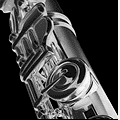

A Symphony
of Old and New: Oberlin's C.B. Fisk Organ ...continued Fisk
has even outdone one of Cavaillé-Coll's own innovations
– his Barker Lever, a pneumatic assist. Fisk's answer is
the Servopneumatic Lever. Fisk
has even outdone one of Cavaillé-Coll's own innovations
– his Barker Lever, a pneumatic assist. Fisk's answer is
the Servopneumatic Lever.The Barker Lever solved certain romantic-era mechanical problems. Keys within a manual could be coupled (a key automatically playing its octave, for example), and manuals themselves could be coupled, so that a single keystroke opened multiple valves. With all these mechanisms in play, the necessary key pressure would be unwieldy, says Thomson. "You'd need to exert an excessive amount of finger and foot pressure to push the keys down." The Barker Lever – incorporated in the Grand Orgue division – augmented the organist's key action with pneumatic pressure. But the Barker Lever created an on-off effect and was maintenance intensive. Like Barker Levers, Fisk's Servopneumatic Levers augment the keystrokes of the Grand Orgue, but through an ingenious mechanical arrangement invented by long-time Fisk employee, Stephen Kowalyshyn, they track the keystroke, allowing the organist to open the valve slowly or suddenly, as he or she wishes.  The
organ's designers have deftly added elements necessary to 20th-century
music: a few more keys in each division and a handful of new stops.
Using the organ's computerized system, an organist can preset
myriad registrations (stop combinations), and put each into effect
at the touch of a button. Or the player can use the French Mode, in
which the spoon-shaped bronze foot pedals recreate Cavaillé-Coll's
innovative mechanism for changing registrations. The
organ's designers have deftly added elements necessary to 20th-century
music: a few more keys in each division and a handful of new stops.
Using the organ's computerized system, an organist can preset
myriad registrations (stop combinations), and put each into effect
at the touch of a button. Or the player can use the French Mode, in
which the spoon-shaped bronze foot pedals recreate Cavaillé-Coll's
innovative mechanism for changing registrations. "Oberlin is one of two or three institutions in America that have been leaders in organ studies," says Dean of the Conservatory Robert K. Dodson. "This is a fulfillment of that destiny. It speaks to Oberlin's position in the musical universe." "We've been fortunate to build at a lot of the places in the United States where people learn to play the organ," says Fisk vice president Gregory Bover. "Oberlin is perhaps the king . . . of that group. We know the organ will be appreciated." Haskell Thomson throws his head back with delight when asked how he feels about Opus 116. "I go over during the voicing and I play and I listen and I think, ‘Is this real?' David (Boe) and I worked on this project for 10 years. The thought of moving from abstractions, from pure paper, to this living thing that is being built up right in front of our eyes – it's absolutely incredible!" Go to Page 1 | 2
of A SYMPHONY OF OLD AND NEW
|